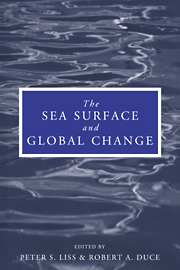Book contents
- Frontmatter
- Contents
- List of contributors
- Preface
- 1 Report Group 1 – Physical processes in the microlayer and the air–sea exchange of trace gases
- 2 Report Group 2 – Biological effects of chemical and radiative change in the sea surface
- 3 Report Group 3 – Photochemistry in the sea-surface microlayer
- 4 Transport processes in the sea-surface microlayer
- 5 The role of organic films in air–sea gas exchange
- 6 Bubbles and their role in gas exchange
- 7 The physical chemistry of air–sea gas exchange
- 8 The sea-surface microlayer and its effect on global air–sea gas transfer
- 9 Chemistry of the sea-surface microlayer
- 10 Biophysics of the surface film of aquatic ecosystems
- 11 Biological effects of chemicals in the sea-surface microlayer
- 12 Neuston of seas and oceans
- 13 Photochemistry in the sea-surface microlayer
- 14 Hydrocarbon breakdown in the sea-surface microlayer
- 15 Applications of laser technology and laser spectroscopy in studies of the ocean microlayer
- 16 Remote sensing of the sea-surface microlayer
- Index
12 - Neuston of seas and oceans
Published online by Cambridge University Press: 24 September 2009
- Frontmatter
- Contents
- List of contributors
- Preface
- 1 Report Group 1 – Physical processes in the microlayer and the air–sea exchange of trace gases
- 2 Report Group 2 – Biological effects of chemical and radiative change in the sea surface
- 3 Report Group 3 – Photochemistry in the sea-surface microlayer
- 4 Transport processes in the sea-surface microlayer
- 5 The role of organic films in air–sea gas exchange
- 6 Bubbles and their role in gas exchange
- 7 The physical chemistry of air–sea gas exchange
- 8 The sea-surface microlayer and its effect on global air–sea gas transfer
- 9 Chemistry of the sea-surface microlayer
- 10 Biophysics of the surface film of aquatic ecosystems
- 11 Biological effects of chemicals in the sea-surface microlayer
- 12 Neuston of seas and oceans
- 13 Photochemistry in the sea-surface microlayer
- 14 Hydrocarbon breakdown in the sea-surface microlayer
- 15 Applications of laser technology and laser spectroscopy in studies of the ocean microlayer
- 16 Remote sensing of the sea-surface microlayer
- Index
Summary
Abstract
The first investigations of marine neuston (surface-dwelling organisms) were conducted in the 1950s and focused on the taxonomic diversity and abundance of organisms. Later investigators examined the physics, chemistry and exchange processes between the atmosphere and ocean. Today, we know the ocean–atmosphere interface is important for many biogeochemical processes essential for life.
Physical, chemical and biological conditions differ greatly between the uppermost 5 cm of the ocean and the water below. The marine pleuston includes the larger siphonophores, Physalia and Velella, which float on the surface. Neuston can be divided into epineuston and hyponeuston. The epineuston includes more than 40 species of water striders, Halobates, inhabiting the open ocean and coastal areas. The hyponeuston are organisms in the surface centilayer including hydrozoa, molluscs, copepods, isopods, decapod crustaceans, fishes, and the seaweed Sargassum.
The neuston connect the sea surface and water column as larvae develop and migrate downward, and adult animals visit the surface to feed and reproduce. The sea surface has become a site of significant enrichment of pollutants from terrestrial and atmospheric sources. The spatial coincidence of the maximum pollutant concentrations and the biological sensitivity of its inhabitants creates a critical situation in the marine environment.
High densities of neustonic organisms in the sea surface can influence air–sea exchange processes (as discussed in Chapter 10, this volume).
- Type
- Chapter
- Information
- The Sea Surface and Global Change , pp. 371 - 382Publisher: Cambridge University PressPrint publication year: 1997
- 12
- Cited by



